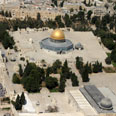
Arab population in Jerusalem growing, study says
Growth rate of Arab population in city in past 40 years is double that of Jewish population, data published by Jerusalem Institute for Israel Studies reveals. In 2020, Arabs expected to constitute 40 percent of capital's residents
The State of Israel will mark 40 years of the re-unification of Jerusalem next week.
Out of approximately 720,000 Jerusalem residents, the Jews constitute 66 percent of the population. According to the institute, if this trend continues, in 2020 the Jewish population will drop to 60 percent and the Arab population will reach 40 percent, and in 2035 it will reach 50 percent.
At the end of 1967 the Jewish population included 266,300 people. Since then it has grown rapidly, reaching 719,900 people at the end of 2005 – a rise of 170 percent.
The Arab population, however, has grown even faster over the four decades since the Six Day War. While the Jewish population grew from 197,700 people to 475,100 people, (a rise of 140 percent), the Arab population grew from 68,600 people in 1967 to 244,800 people (a rise of 257 percent).
The relatively slow growth rate of the Jewish population has led to a drop in its percentage in the city, from 74 percent in 1967 to 66 percent in 2005. Simultaneously, the Arab population rose from 26 percent to 34 percent.
Only in the past decade, the Arab population's annual growth rate rose by 3 to 4 percent. In the past decade the Arab population's growth rate was more than double that of the Jewish population.
Remove neighborhoods, add attractions
The institution's researchers said that the data presented a contradiction between the reality in Jerusalem and the declared government policy of maintaining the Jewish majority in Jerusalem since the city's re-unification.
What do they suggest? "We are raising a number of alternatives, such as expanding Jerusalem's border to the west, removing Arab neighborhoods from the city's municipal area and making Jerusalem more attractive for the young people and middle class," Dr Maya Hoshen, a researcher at the institute, told Ynet.
Officials at the institute also said that on the eve of the Six Day War, Jerusalem's area under Israeli sovereignty was only 38 square meters, and after the war the government added another 70 square meters. Today this area is the area of east Jerusalem, where Jewish neighborhoods are also built.
"We are saying it is true that the proportion between the populations in the city is significant, but the population's characteristics are as important. It is important to attract young people and the middle class from both sectors," a researcher said.










